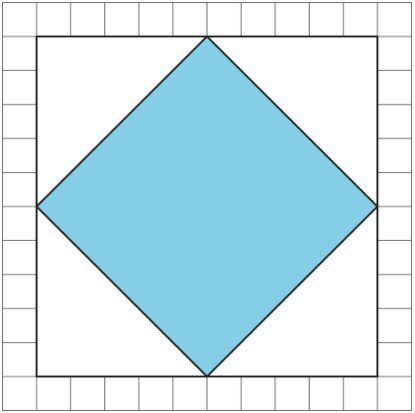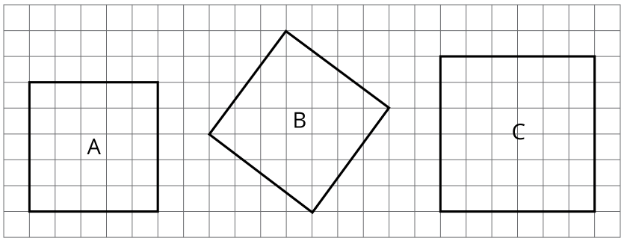8.1.1: The Areas of Squares and Their Side Lengths
- Page ID
- 37741
\( \newcommand{\vecs}[1]{\overset { \scriptstyle \rightharpoonup} {\mathbf{#1}} } \)
\( \newcommand{\vecd}[1]{\overset{-\!-\!\rightharpoonup}{\vphantom{a}\smash {#1}}} \)
\( \newcommand{\id}{\mathrm{id}}\) \( \newcommand{\Span}{\mathrm{span}}\)
( \newcommand{\kernel}{\mathrm{null}\,}\) \( \newcommand{\range}{\mathrm{range}\,}\)
\( \newcommand{\RealPart}{\mathrm{Re}}\) \( \newcommand{\ImaginaryPart}{\mathrm{Im}}\)
\( \newcommand{\Argument}{\mathrm{Arg}}\) \( \newcommand{\norm}[1]{\| #1 \|}\)
\( \newcommand{\inner}[2]{\langle #1, #2 \rangle}\)
\( \newcommand{\Span}{\mathrm{span}}\)
\( \newcommand{\id}{\mathrm{id}}\)
\( \newcommand{\Span}{\mathrm{span}}\)
\( \newcommand{\kernel}{\mathrm{null}\,}\)
\( \newcommand{\range}{\mathrm{range}\,}\)
\( \newcommand{\RealPart}{\mathrm{Re}}\)
\( \newcommand{\ImaginaryPart}{\mathrm{Im}}\)
\( \newcommand{\Argument}{\mathrm{Arg}}\)
\( \newcommand{\norm}[1]{\| #1 \|}\)
\( \newcommand{\inner}[2]{\langle #1, #2 \rangle}\)
\( \newcommand{\Span}{\mathrm{span}}\) \( \newcommand{\AA}{\unicode[.8,0]{x212B}}\)
\( \newcommand{\vectorA}[1]{\vec{#1}} % arrow\)
\( \newcommand{\vectorAt}[1]{\vec{\text{#1}}} % arrow\)
\( \newcommand{\vectorB}[1]{\overset { \scriptstyle \rightharpoonup} {\mathbf{#1}} } \)
\( \newcommand{\vectorC}[1]{\textbf{#1}} \)
\( \newcommand{\vectorD}[1]{\overrightarrow{#1}} \)
\( \newcommand{\vectorDt}[1]{\overrightarrow{\text{#1}}} \)
\( \newcommand{\vectE}[1]{\overset{-\!-\!\rightharpoonup}{\vphantom{a}\smash{\mathbf {#1}}}} \)
\( \newcommand{\vecs}[1]{\overset { \scriptstyle \rightharpoonup} {\mathbf{#1}} } \)
\( \newcommand{\vecd}[1]{\overset{-\!-\!\rightharpoonup}{\vphantom{a}\smash {#1}}} \)
Lesson
Let's investigate the squares and their side lengths.
Exercise \(\PageIndex{1}\): Two Regions
Which shaded region is larger? Explain your reasoning.

Exercise \(\PageIndex{2}\): Decomposing to Find Area
Find the area of each shaded square (in square units).
1.

2.

3.

Are you ready for more?
Any triangle with a base of 13 and a height of 5 has an area of \(\frac{65}{2}\).

Both shapes in the figure have been partitioned into the same four pieces. Find the area of each of the pieces, and verify the corresponding parts are the same in each picture. There appears to be one extra square unit of area in the right figure. If all of the pieces have the same area, how is this possible?
Exercise \(\PageIndex{3}\): Estimating Side Lengths from Areas

- What is the side length of square A? What is its area?
- What is the side length of square C? What is its area?
- What is the area of square B? What is its side length? (Use tracing paper to check your answer to this.)
- Find the areas of squares D, E, and F. Which of these squares must have a side length that is greater than 5 but less than 6? Explain how you know.

Exercise \(\PageIndex{4}\): Making Squares
Use the applet to determine the total area of the five shapes, \(D\), \(E\), \(F\), \(G\), and \(H\). Assume each small square is equal to 1 square unit.
Summary
The area of a square with side length 12 units is \(12^{2}\) or 144 units2.
The side length of a square with area 900 units2 is 30 units because \(30^{2}=900\).
Sometimes we want to find the area of a square but we don’t know the side length. For example, how can we find the area of square \(ABCD\)?
One way is to enclose it in a square whose side lengths we do know.

The outside square \(EFGH\) has side lengths of 11 units, so its area is 121 units2. The area of each of the four triangles is \(\frac{1}{2}\cdot 8\cdot 3=12\), so the area of all four together is \(4\cdot 12=48\) units2. To get the area of the shaded square, we can take the area of the outside square and subtract the areas of the 4 triangles. So the area of the shaded square \(ABCD\) is \(121-48=73\) or 73 units2.

Practice
Exercise \(\PageIndex{5}\)
Find the area of each square. Each grid square rpresents 1 square unit.

Exercise \(\PageIndex{6}\)
Find the length of a side of a square if its area is:
- \(81\) square inches
- \(\frac{4}{25}\) cm2
- \(0.49\) square units
- \(m^{2}\) square units
Exercise \(\PageIndex{7}\)
Find the area of a square if its side length is:
- 3 inches
- 7 units
- 100 cm
- 40 inches
- \(x\) units
Exercise \(\PageIndex{8}\)
Evaluate \((3.1\times 10^{4})\cdot (2\times 10^{6})\). Choose the correct answer.
- \(5.1\times 10^{10}\)
- \(5.1\times 10^{24}\)
- \(6.2\times 10^{10}\)
- \(6.2\times 10^{24}\)
(From Unit 7.3.6)
Exercise \(\PageIndex{9}\)
Noah reads the problem, “Evaluate each expression, giving the answer in scientific notation.” The first problem part is: \(5.4\times 10^{5}+2.3\times 10^{4}\).
Noah says, “I can rewrite \(5.4\times 10^{5}\) as \(54\times 10^{4}\). Now I can add the numbers: \(54\times 10^{4}+2.3\times 10^{4}=57.3\times 10^{4}\).”
Do you agree with Noah’s solution to the problem? Explain your reasoning.
(From Unit 7.3.7)
Exercise \(\PageIndex{10}\)
Select all the expressions that are equivalent to \(3^{8}\).
- \((3^{2})^{4}\)
- \(8^{3}\)
- \(3\cdot 3\cdot 3\cdot 3\cdot 3\cdot 3\cdot 3\cdot 3\)
- \((3^{4})^{2}\)
- \(\frac{3^{6}}{3^{-2}}\)
- \(3^{6}\cdot 10^{2}\)
(From Unit 7.2.5)


